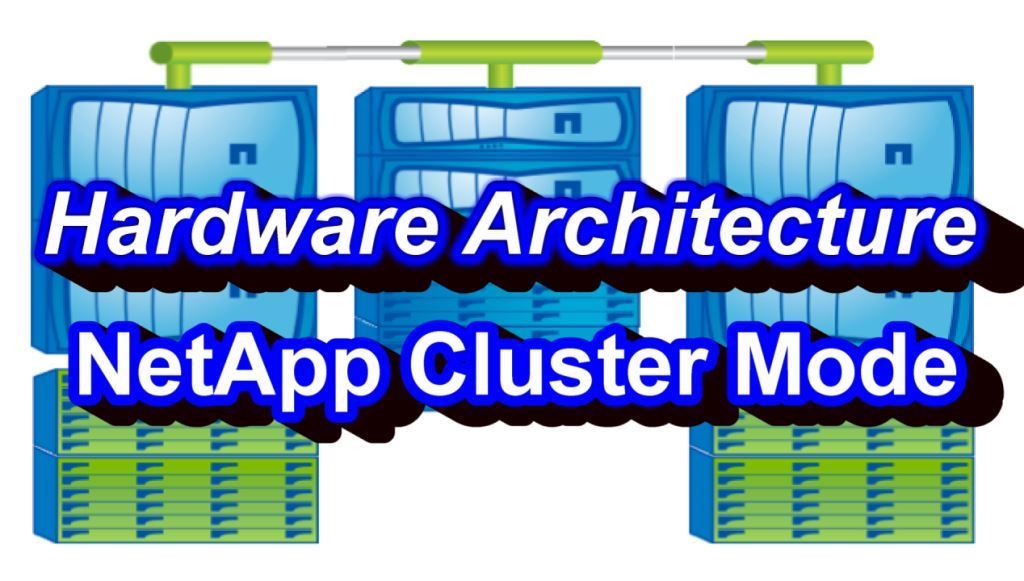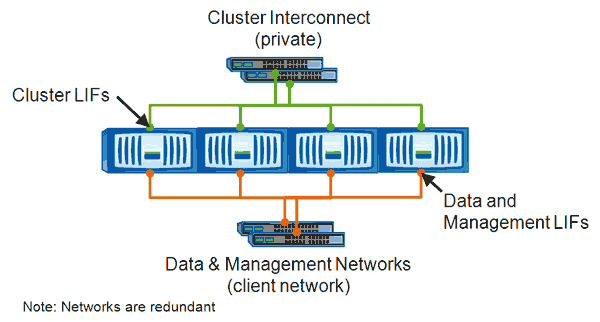In this post, we will discuss NetApp Cluster-Mode hardware architecture. This includes various Components of NetApp cluster mode, how Netapp hardware components are connected to each other.
Then we will discuss the types of cluster mode and finally, we will see how data requests flow in NetApp cluster mode.

NetApp Cluster-Mode Architecture
There are three main hardware components of the NetApp cluster mode. We will discuss them in detail about them.
1. Nodes or Controllers
Nodes or controllers are the computing part of the NetApp Cluster. They process all incoming and outgoing requests for the cluster.
Netapp nodes have slots that contain IO/Module. These modules contain NetApp ports for Ethernet, FC, FCoE, and SAS connectivity.
Ethernet ports connect to network switches for LAN connectivity. Similarly, FC port connects to SAN switches for FC connectivity. To know more about the FC connectivity you can read or post on SAN Architecture.
You can use FCoE for both Ethernet and FC connections. Finally, SAS ports connect the controllers to disk shelves.
NetApp nodes also contain other hardware such as NVRAM, CPU, PSU, and Fans.
2. Disk Shelves
Disk shelves in Netapp Cluster Mode consist of Physical disks. NetApp supports various types of disk. Disk shelves and controller are connected to each other via SAS ports.

In an HA Pair, the disk shelves are connected to both controllers. So that if one controller fails then the other controller takes care of the data request.
3. Inter-Cluster Switches
Intercluster switches are also known as cluster switches. These are nothing but network switches that provides the connection between NetApp controllers.
Each node in the cluster has a minimum of two cluster ports which connects to cluster switches.

What Is Cluster-Mode NetApp?
Cluster Mode NetApp is basically a grouping of multiple HA Pair Nodes. These nodes are interconnected via Inter-Cluster Switches that creates a cluster of nodes.
There are three types of cluster mode. The first one is Single Node Cluster, Switchless Cluster, and Cluster with switches.
Netapp Cluster Mode can have a maximum number of 24 nodes that means 12 HA Pairs. However, in the case of FC or mixed protocol, it can have only 8 nodes.
Single Node Netapp Cluster
A Single node NetApp cluster has only one node. The single-node cluster does not provide any redundancy. Hence, there is always a risk of outage and data loss.
Two Node Switchless Cluster
Two nodes switchless cluster has two nodes in an HA pair. These nodes are connected to each other directly and not via inter-cluster switches.
The direct connection between two nodes for data flow is called Cluster Interconnect.
NetApp Cluster With Cluster Switch
You can also use intercluster switches to connect two nodes. Intercluster switches help in the scalability of the cluster.
Multiple Nodes with Inter-Cluster Switch
A NetApp Cluster can also have more than two nodes up to 24 nodes. All Nodes connect to two cluster switches. In the next section, we will discuss how IO flows through the network.
How Data Flows In NetApp Cluster Mode
First, read or write request comes to any one of the NetApp nodes. Data Ontap checks if the data resides on the local node or remote node.
If Data found in a local node then the requests are processed and sent back to the client through the same path. Now, if data exists in the remote node then Data Ontap sends the request to the remote node via cluster network.
Then remote node process the data and sends back processed and the data back to the client through the same path.
I hope you gain some knowledge of the hardware architecture of the NetApp cluster mode. Subscribe our newsletter for more such content. You can also subscribe to our YouTube channel for video tutorials.




